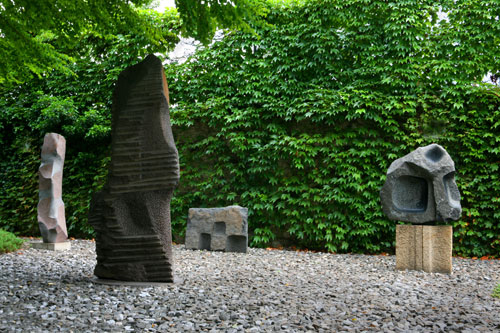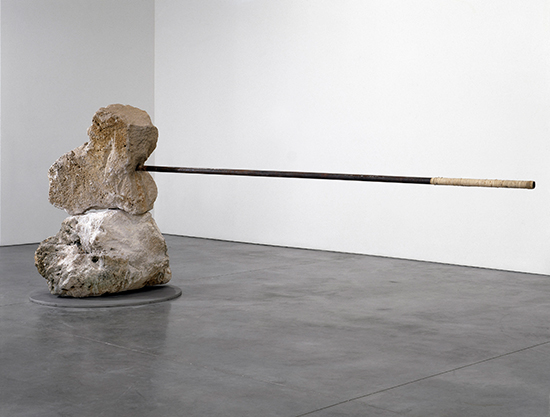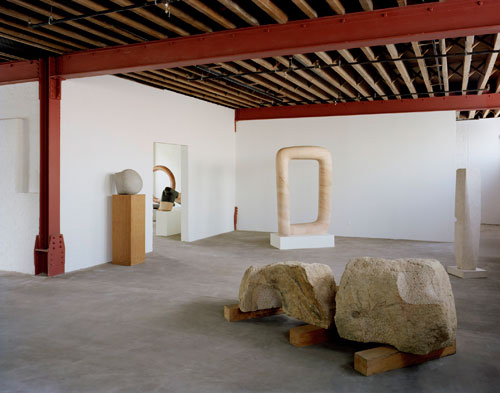The Noguchi Museum is focusing on a familiar material for a first-of-its-kind exhibition for the art museum. Using stone as muse, "Museum of Stone" brings together a range of historic and contemporary artists and artisans who work with or are inspired by stone. The show opens October 7, 2015 and continues through January 10, 2016.
“Museum of Stones” features over 50 works by nearly 30 artists installed in conversation with works by Noguchi. Exhibiting work by contemporary artists amid their collection is ground breaking for the Long Island City museum, which is devoted to exhibiting and fostering the art and legacy of American artist Isamu Noguchi (1904-1988).
.

Sculpture by Isamu Noguchi. Courtesy of the Noguchi Museum.
.
Curators have culled sculptures, drawings, photographs, objects and more from several sources, including artists' and private collections, estates, the Chicago Institute of Art and the Jewish Museum. The Metropolitan Museum of Art also loaned art and objects for the exhibition. Included from their collection are 16 Chinese paintings, hanging scrolls, folding fans and other items created over six centuries.
The exhibition aims to ground Noguchi’s artistic philosophies on stone within civilization's longtime regard of the material as muse. The show will occupy several areas, at some points replacing permanent Noguchi gallery pieces for the first time. The second floor will be entirely dedicated to the exhibition.
“This is the biggest, most complicated show we’ve ever done, by far,” Noguchi Museum Senior Curator Dakin Hart said in a phone interview.
Hart added that the placement of the non-Noguchi pieces in particular are meant to “build bridges between wide time gaps,” as well as play off specific elements of nearby Noguchi works.
A lynchpin is The Dangers of Petrification, an assemblage of rocks arranged to look like food, by artist and essayist Jimmie Durham. Durham has argued that stone in nature has a liveliness often not captured or ignored in sculpture and architecture. His writings and opinions on the subject helped inspire the exhibition.
While the exhibition includes pieces from centuries past, to highlight early use of the ancient geological material, the exhibition focuses on contemporary art from the 1970s onward. Included are works by Tom Sachs, Gabriel Orozco, Mel Bochner, Scott Burton, Dove Bradshaw, Yoko Ono, Keith Sonnier, John Perreault, Rupert Norfolk, Richard Long, J.B. Blunk, Lawrence Weiner and Janine Antoni.
In one of the indoor-outdoor galleries—which many visitors will see first—are six half-ton boulders of volcanic rock glazed in bright red ceramic paint by Mexican artist Bosco Sodi. Hart said these pieces not only feature the central theme of stone, but also stand as almost an obverted version of the planet, Earth, that so inspired Noguchi, with rock at the core in this case and a molten-like material coating the outside.
In the garden will be several sculptures by Dove Bradshaw, on loan from three collections, which draw on Bradshaw's ruminations on erosion and similar geologic phenomena. This includes Waterstone, a piece where water drips from a suspended glass funnel onto a limestone cube, exposing the mutability of stone.
On the ground floor, Janine Antoni’s and, a sculpture of two 800-pound stacked limestone boulders with a protruding 11-foot-long steel rod, will replace Noguchi’s Ding Dong Bat. Hart acknowledged that in this swap there is a subtle exchange of one phallic shape for another.
.

"and" by Janine Antoni, 1996-99. Two 800 lb. limestone boulders, steel rod. © Janine Antoni; Courtesy of the artist and Luhring Augustine, New York.
.
Also on the ground floor will be an untitled sculpture by Stephen Lichty: a six-and-a-half-foot basalt column with a taxidermied cat seemingly draped on top. Curators noted in a press release that this piece brings a new concept to the idea of the public stone monument. The piece will be positioned next to Noguchi’s To Intrude on Nature’s Way, also a basalt column.
.

"Untitled" by Stephen Lichty, 2014. Basalt and taxidermied cat, 78 x 12 x 12 inches. Photo: Mark Woods, courtesy Foxy Production, New York.
.
The second floor is divided into four sections portraying differing applications of stones through time: structures; weapons; collection and classification in the natural sciences; and in abstract thinking.
“What I like about it the most is the paradox; we’re trying to show what a conceptual artist Noguchi was by showing rock,” Hart said.
The area devoted to structures will have several works, including WHAT IS SET UPON THE TABLE SITS UPON THE TABLE, a sculpture of a wood table supporting a piece of trimmed limestone by Lawrence Weiner, combined with a partially carved foundation stone from the Jerusalem wall, on loan from the Jewish Museum..
The section presenting tools looks toward the second probable use early humans had for the material after shelter: protection and war. A charcoal-and-pastel drawing by Howard Rosenthal, for instance, appears to depict an asteroid, a kind of weapon in its own right according to the curators.
In the third section, curators arranged pieces of stone to play on the concept of rock collections. Three pieces by Tom Sachs in display cabinets serving as geological specimens found during “space missions” will be amid eight Noguchi sculptures organized on a table. Playing on the idea of “collection” in context with the displays is Gabriel Orozco’s Yielding Stone, a ball made of flexible and absorbent plasticine Orozco guided around city streets as it picked up different debris and textures.
A highlight of the fourth section, Hart said, is a piece by Toshiko Takaezu whose title translates to “Dry Riverbed.” This work is composed of 41 ceramic "river rocks" and "moons" on loan from the late artist's estate for a first-ever presentation of her vision of the “river,” a scattering of her work that will take up a great portion of the space.
Hart clarified that "Museum of Stone" is not a sign of any departure from its primary focus on Noguchi. Instead, the exhibition is one way the museum is celebrating its 30th anniversary and Isamu Noguchi himself.
“Noguchi loved the planet—he just loved our planet. All of our work is an expression of that,” Hart said. “I hope people go away loving and understanding Noguchi a little bit better and understanding the planet’s history a little bit better.”
.

Sculpture by Isamu Noguchi. Courtesy of the Noguchi Museum.
.
_____________________________
BASIC FACTS: “Museum of Stones” will be exhibited from October 7, 2015 to January 9, 2016. The Noguchi Museum is located at 9-01 33rd Road, Long Island City, NY 11106. www.noguchi.org.
_____________________________
Copyright 2015 Hamptons Art Hub LLC. All rights reserved.
